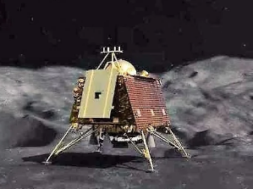
Manas Dasgupta
NEW DELHI, Sept 4: Adding another feather to its cap, the space agency the Indian Space Research Organisation (ISRO) has successfully completed an unexpected experiment making the Vikram lander to perform a second soft landing on the moon’s surface.
What the ISRO called it a “hop experiment,” on command from the ground station it made the lander lift itself about 40 CM from the surface and re-landed softly about 30-40 CM away. The ISRO has already achieved a major feat registering the history’s first soft-landing on the hitherto unexplored South Pole region of the moon on August 23 and the second soft landing on Monday was not even in its original schedule.
The ISRO said on Monday, “Vikram Lander has exceeded Chandrayaan-3 mission objectives and successfully completed a “hop experiment. On command, it fired the engines, elevated itself by about 40 cm as expected and landed safely at a distance of 30 – 40 cm away,” the ISRO said.
This successful hop experiment and kickstart could have significant bearing on the future missions which are launched with an objective to bring back samples from the moon and also future human missions to the moon.
The space agency said Vikram’s systems are healthy and performed nominally. “Vikram’s systems deployed ramp, equipment folded back and redeployed successfully after the experiment,” it said. “Deployed Ramp, ChaSTE and ILSA were folded back and redeployed successfully after the experiment,” the ISRO added.
Last week, the Chandrayaan-3 mission’s Pragyan rover was “set into Sleep mode” but with batteries charged and receiver on. The battery was fully charged and the solar panel was oriented to receive the light at the next sunrise expected on September 22, it added. “Hoping for a successful awakening for another set of assignments. Else, it will forever stay there as India’s lunar ambassador,” the space agency said.
India made history as the first country to land near the south pole of the moon with its Chandrayaan-3 lander last month.
Chandrayaan-3’s soft, textbook touchdown after a failed attempt in 2019 has sparked widespread jubilation in the country. Since then one of the payloads onboard the Vikram while conducting in-situ measurements has indicated the presence of plasma near the lunar surface. Two payloads have detected and confirmed sulphur in the moon’s south polar region.
The landing, which came just days after a Russian lander crashed in the same region, is being seen as India’s greatest scientific feat. The country has been steadily matching the achievements of other space programmes at a fraction of their cost. ISRO’s first Sun mission, Aditya-L1, was launched successfully last week. The key objectives of the mission are understanding the coronal heating and solar wind acceleration.
ISRO is slated to launch a three-day crewed mission into Earth’s orbit by next year. It also plans a joint mission with Japan to send another probe to the Moon by 2025 and an orbital mission to Venus within the next two years.














